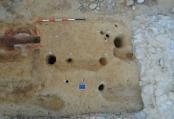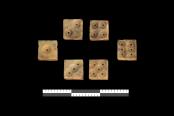CAMPAGNA 2018 |
1° SETTIMANA |
2° SETTIMANA |
3° SETTIMANA |
4° SETTIMANA |
5° SETTIMANA |
6° SETTIMANA |
7° SETTIMANA |
8° SETTIMANA |
9° SETTIMANA |
19 LUGLIO 2018 
Resoconto della giornata di scavo
Generale
Tre cose solamente m’ènno in grado,
le quali posso non ben ben fornire,
cioè la donna, la taverna e ’l dado:
queste mi fanno ’l cuor lieto sentire.
(Cecco Angiolieri)
Un dado in osso, con lo spigolo di appena 0,6 mm, è stato rinvenuto in compagnia di una fusaiola e di un frammento di boccale invetriato (importazione dalla Spagna islamica?) entro una buca realizzata nella prima metà XII secolo. I fori sulle facce sono naturalmente “ad occhio di dado”, cioè realizzati a trapano con fori concentrici. La somma delle facce contrapposte dà come risultato sempre 7, una caratteristica che sembra generalizzarsi nei dadi proprio a partire dal XII secolo. Il gioco dei dadi era severamente proibito dalla Chiesa durante il Medioevo, proibizione che era assoluta e prescrittiva per i religiosi e pertanto, probabilmente, alquanto disattesa anche tra il clero. In Toscana si hanno diversi ritrovamenti di dadi “archeologici”, in genere basso medievali, da contesti militari come castelli o fortezze. Più raro il ritrovamento di simili oggetti in ambito monastico. Nello scavo del Monastero di San Michele alla Verruca sul Monte Pisano sono effettivamente stati rinvenuti alcuni dadi, ma tutti riconducibili all’utilizzo militare del sito durante la guerra tra Pisa e Firenze, agli inizi del XV secolo.
E’ impossibile stabilire chi usò questo oggetto, rinvenuto nel riempimento di una buca legata ai lavori di edificazione del chiostro abbaziale: monaci? maestranze impegnate nel cantiere? ospiti occasionali della canonica di Pozzeveri? Qualsiasi risposta rischia di essere aleatoria…unica cosa certa, qualcuno ha giocato d’azzardo a Badia Pozzeveri intorno agli inizi del XII secolo.
A bone dice, with length of just 0.6 mm, was found in along with a loom weight and a fragment of glazed jug (imported from Islamic Spain?) inside a 12th century pit. The holes on the faces of the dice were made with a drill with concentric holes. The sum of the opposing faces always results in 7, a feature that seems to be common in dice starting from the twelfth century. The game of dice was strictly prohibited by the Church during the Middle Ages, however it was in fact probably quite disregarded even among the clergy. In Tuscany there are several findings of "archaeological" dice, usually from the low medieval period, found in military contexts such as castles or fortresses. The discovery of such objects in a monastic context is rarer. In the excavation of the Monastery of San Michele alla Verruca on Monte Pisano some dice were found, but all attributed to the military use of the site during the war between Pisa and Florence, at the beginning of the fifteenth century.
It is impossible to determine who used this object, found in the fill of a pit linked to the construction of the abbey cloister: monks? workers involved in the construction site? occasional guests of the rectory of Pozzeveri? Any answer is likely to be uncertain ...the only certain thing, someone gambled in Badia Pozzeveri around the beginning of the twelfth century.
Area 3000
Nella porzione settentrionale del settore è stata completata l’indagine di tutte le buche di forma circolare che tagliano un livello precedente la fase cimiteriale di XI secolo e che dovevano ospitare dei pali per il sostegno di una struttura in legno. Nella porzione meridionale continua l’abbassamento generale del settore, con lo scopo di rimuovere i risparmi delle tombe di XI secolo e mettere in luce le fasi di frequentazione più antiche.
Today in the southern half of section B was cleaned and at least 4 soil discolorations indicative of holes were found. The fill of several cuts previously excavated was fully removed and while removing the remaining fill in the grave containing USK3905 the remaining foot bones were found and removed. Then the North half of section B was leveled several centimeters. Tomorrow we will continue down to the level of the East West Trench that bisects section B.
Area 5000
Today, we gave a tour of our areas to the students of the University of Pisa's summer school. During this, we had to describe the features of our trench, the history of the site relating to the excavation, and possible interpretations of the findings. We had a chance to attend the tours of the other areas. Following this, two of the members of our team continued to level down the cut in the East of section C. A cow bone and a large piece of slate were found, along with a a large tipped boulder - the significance of which is not yet know. Further findings of human remains have led to the speculation that this may be a grave. At the charcoal deposit, members of our team first cleaned the feature by removing the majority of the loose dirt away, using spoons. The feature was then photographed, before excavation resumed. We then began to lower down the level of the other side of the bell furnace, in order to expose the full extent of the charcoal deposit. In Section D, we continued to level down the trench and found a number of bone fragments (animal and human). A portion of a skull was discovered along with a larger bone fragment.
Area 6000
Today in area 6000 we continued to remove fill 6217. We found a right clavicle that seems to correspond to the left scapula. The next step is to continue to remove the fill from 6217 to make it level.
We moved forward with removing fill 6235 and discovered that there is indeed a skull. In order for this discovery to happen, we had to begin excavating in a separate context. While we were uncovering the skull, we encountered many rocks that are impeding the full articulation of the skeletal remains as well as a strong root that had grown through the region of the mandible.











